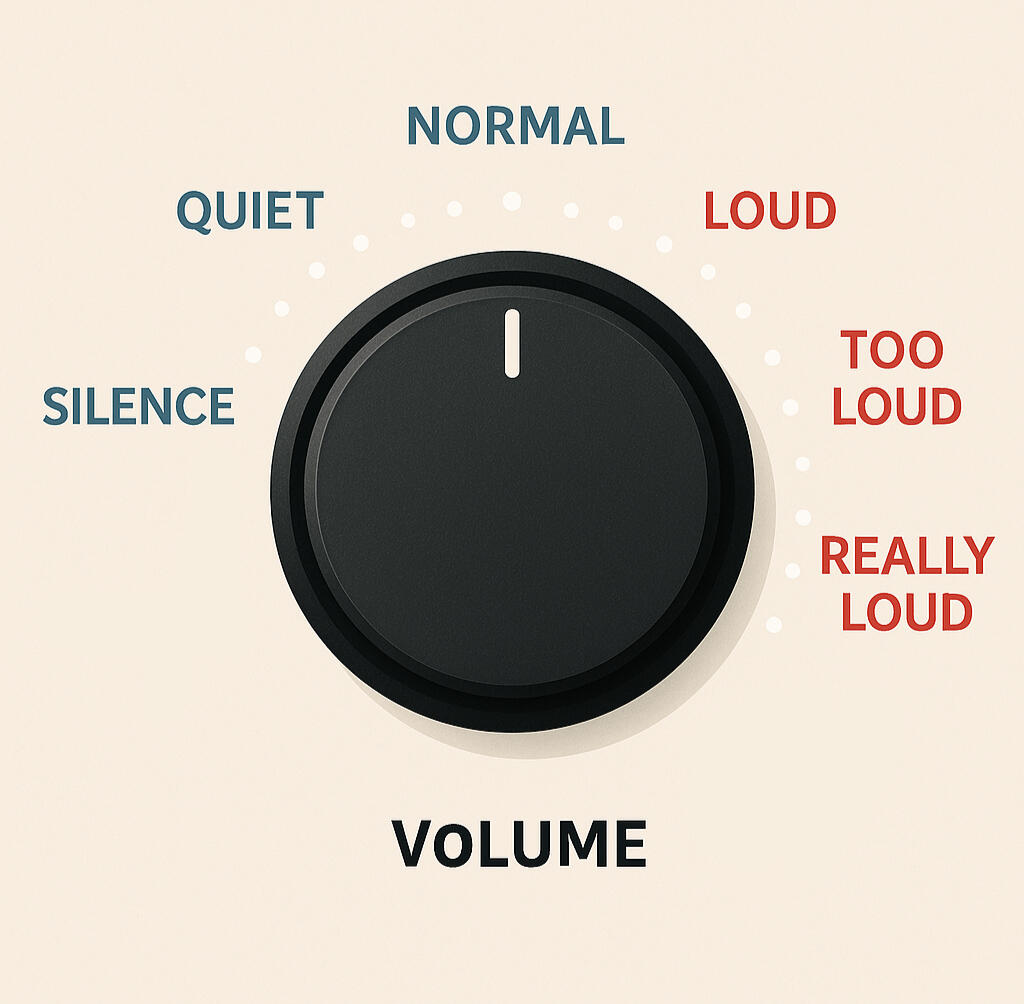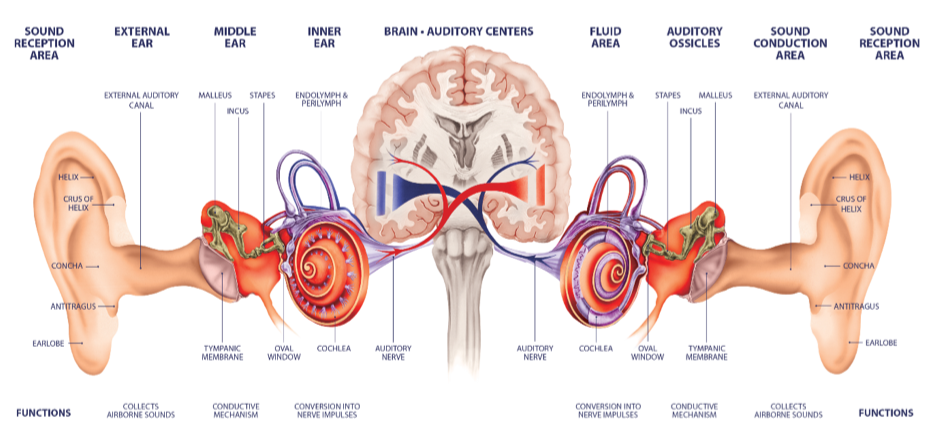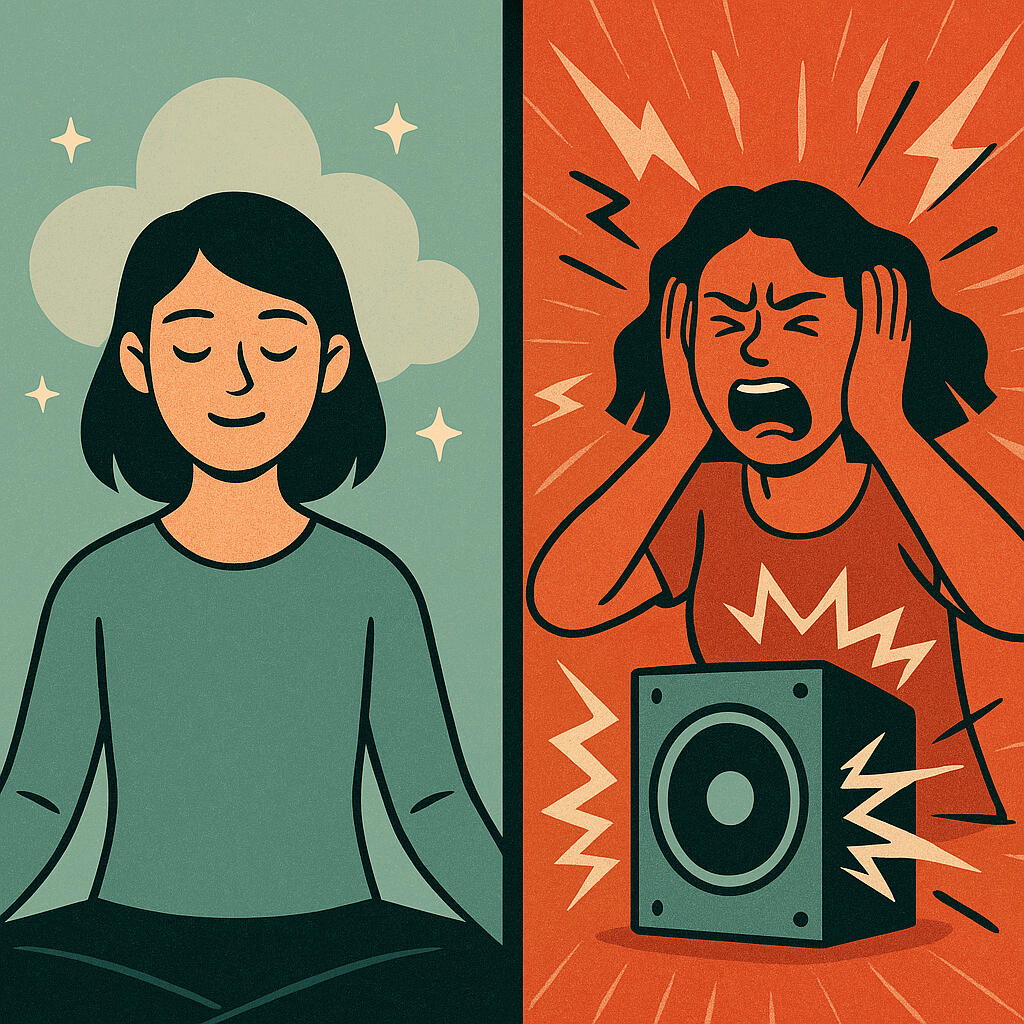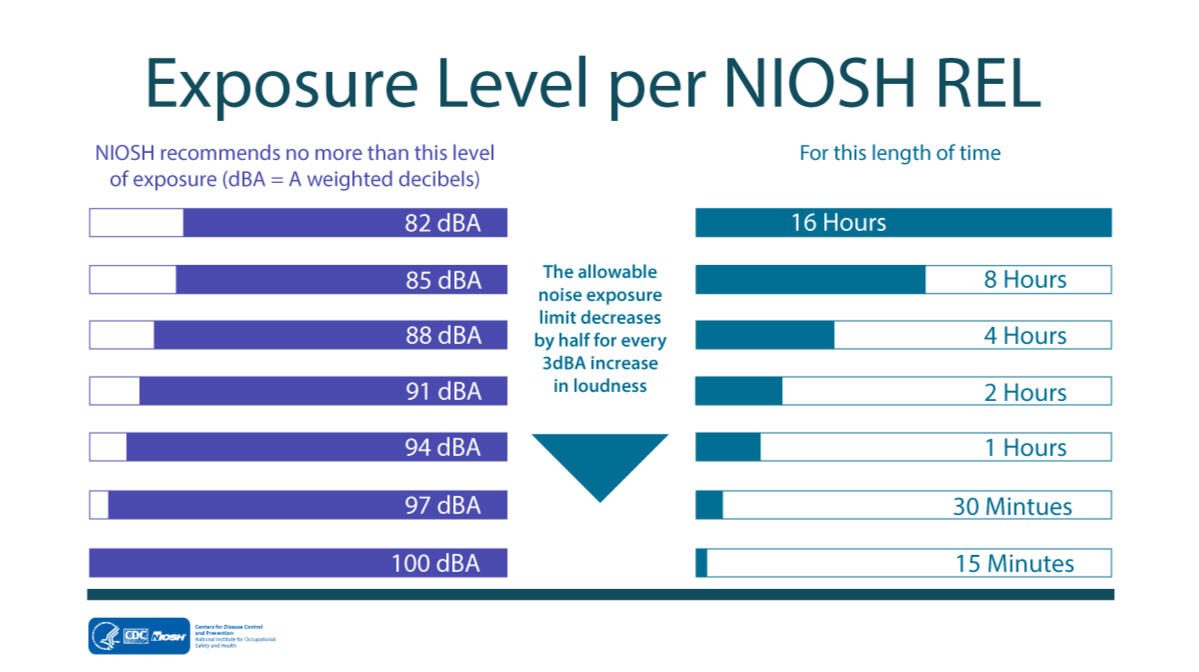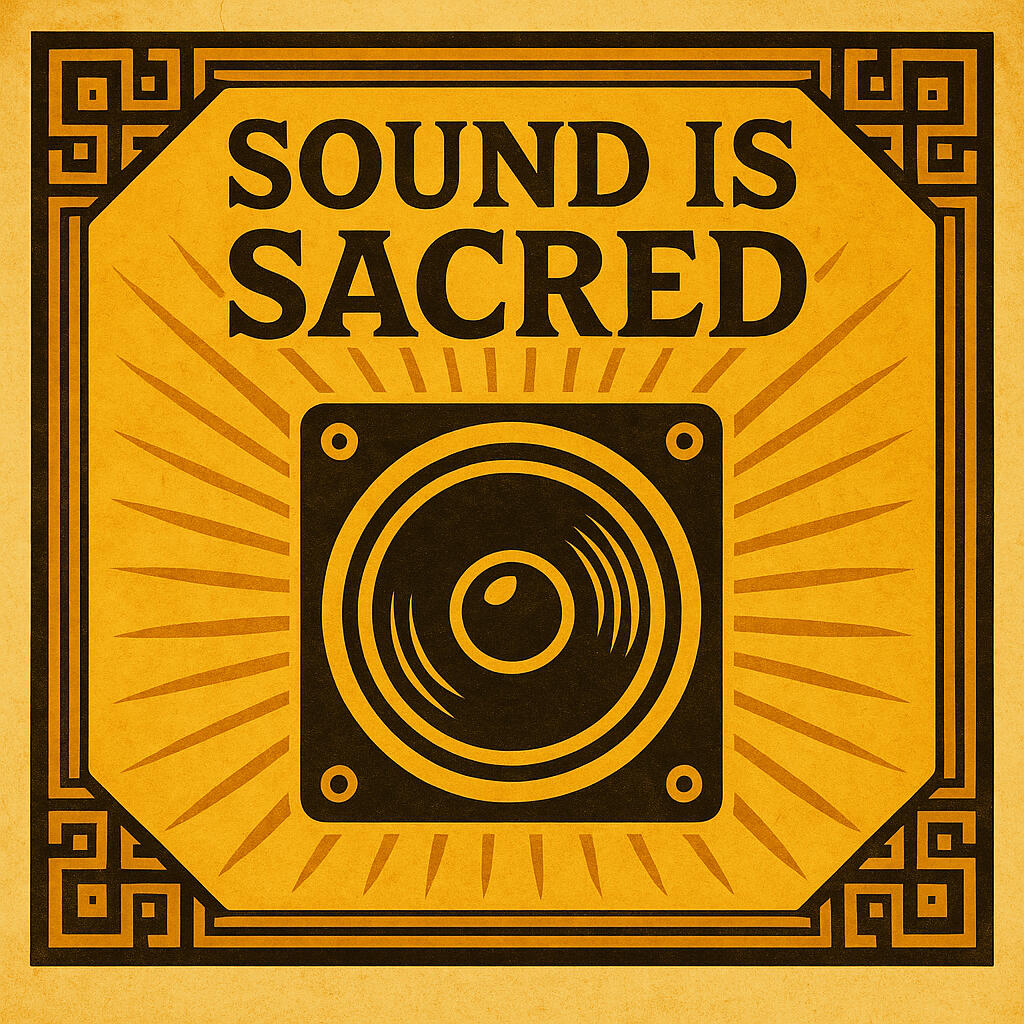
“Sound is a powerful tool to shift consciousness, promote healing, and transform reality.” – Jonathan Goldman
🌟 Our Mission
At SharedSound.Space, we are raising awareness about healthy sound levels in wellness environments. How to empower people to practice healthy self-care of their senses.In a world increasingly popular with sensory input, yoga and meditation can offer refuge. It can also offer amazing experiences with music and sounds at safe levels. Measuring this is like measuring heart-rate, and taking care of yourself and your body is a personal responsibility.Across the modern yoga industry, many students are unknowingly exposed by studios and teachers to sound levels far-beyond safe limits, as defined by public health experts. https://www.cdc.gov/niosh/noise/
It's "just sound", right?
Do we know why we are instantly calm while listening to a peaceful melody? Actually yes, and you’ve experienced sound’s ability to reduce stress when this happens. We all have, it's biological.How does this happen though?Lowering Cortisol – Studies show that soothing sounds lower cortisol (the stress hormone), making us feel more relaxed.Activating the Parasympathetic Nervous System – Slow, steady sounds help activate the body’s natural relaxation response. This can slow heart rate, lower blood pressure, and ease tension.White Noise and Nature Sounds – Sounds like rain, ocean waves, and even gentle humming create a steady background noise that helps quiet a busy mind.That’s why many people turn to sound healing—a practice where gongs, singing bowls, and other instruments create deep relaxation. It’s like a massage for your whole body and mind, helping you let go of stress and tension.There are wonderful benefits from this. It's important to remember that it is not a "free ride" there are also real dangers. It's like all these benefits (cortisol and parasympathetic systems) all of the sudden going in full reverse. We all jump when a loud noise surprises us. Just as we all get fatigued from loud sounds over an extended period of time. We have developed safety standards for this informed by science. Safety practices that we can bring from the health world and apply them in the wellness space to support healing experiences.
For keeping safe high-powered playlists in flow classes, to enjoy bells and singing bowls, and being equipped that if you get overwhelmed. It's ok to put in earplugs or leave. To get the healing boost from the presence of the music, responsible volume keeps it powerful. Crossing into certain ranges would be considered on a worksite to require hearing protection (cited below). I love sound healing. I also know being aware of bells, bowls, and gongs in sound baths, many spaces are producing 90–120 decibels of sound, however when used with an awareness of their principals are powerful tools of healing. Simple ear plugs will not make a sound gong bath any less powerful, you still feel the frequency waves, they are still there.It is about educating things like why ear-plugs are more like sunglasses for the ears, than they are blindfolds for the eyes. Your body is always experiencing sound, it's an always on sense that exponentially lifts.That means the unit of measure, Decibel was developed to measure signal loss over phone lines, so it is a very unique unit of measure. This means for every 3 decibels, it is twice as loud.The most powerful parts of healing sound work is when the sounds are intentional and safely used. If there were not this as an issue, it wouldn't already be researched and defined clearly in medical journals | https://p:mc.ncbi.nlm.nih.gov/articles/PMC6761269/.We must be aware of our sound like we are aware of our other senses; uncomfortably bright lights, powerful odors, rough or unstable ground. Reducing the stigma against healthy wellness environments. Sound is a space we all share.
SharedSound.Space
How Sound Affects Hearing
Exposure to 85 dB or more over time leads to permanent hearing loss.Sound above 100 dB — often present in indoor fitness settings — can cause damage in literally minutesLoud environments activate the stress response, undermining attempts at relaxation and focusInstructors are especially at risk, often spending hours per day in high-volume conditionsOSHA-1910.95 - Occupational Noise Exposure Regulations
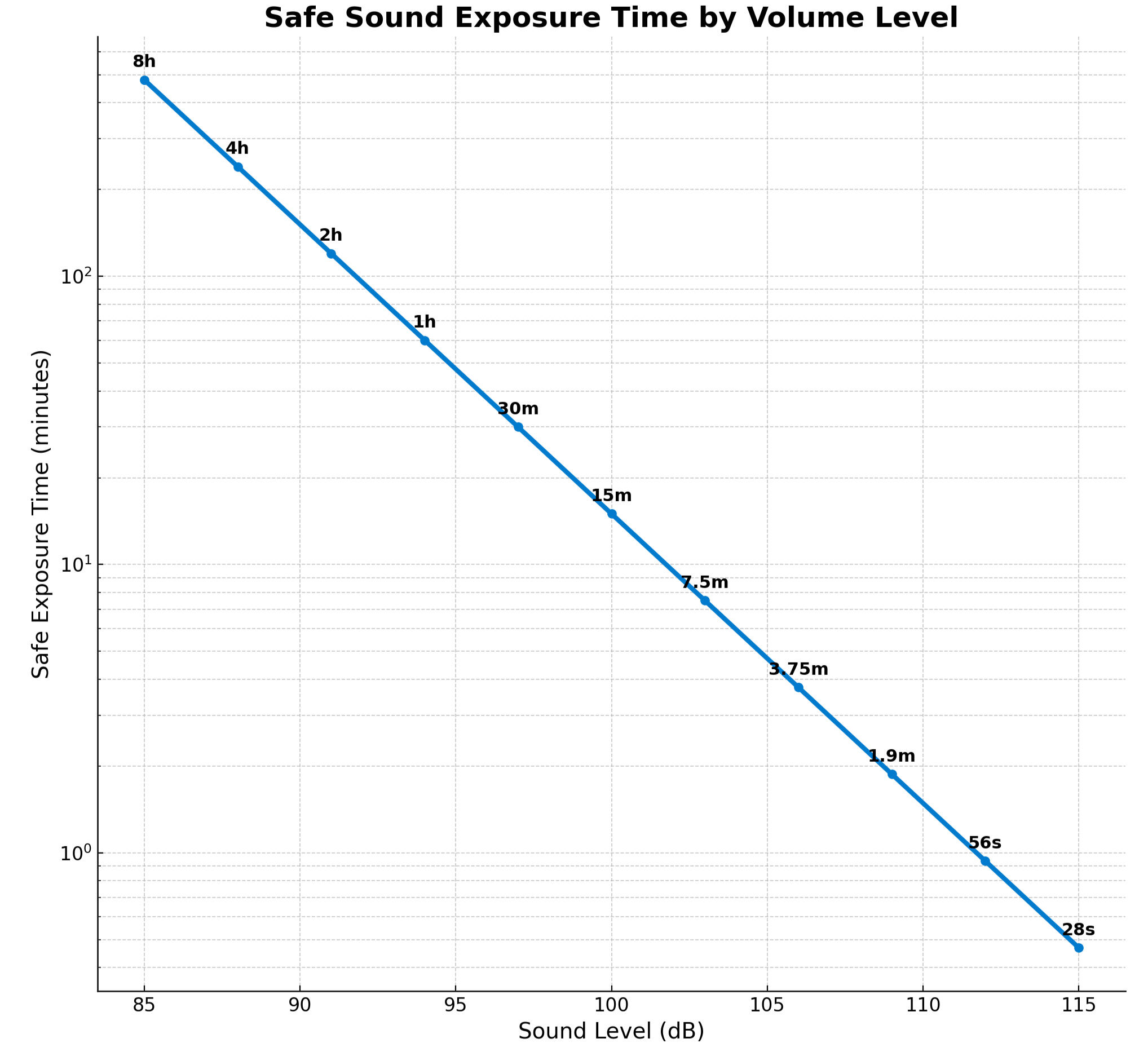
📏 Know the Numbers of Decibel
10 dB – Breathing40-60 dB – Normal conversation82 dB – Garbage Disposal85 dB – Busy Traffic - (Safe for 1 hour)90 dB – Gas Lawn Mower94 dB – Loud playlist - (Safe for 15 minutes)97 dB – Fire alarm100 dB – Loud Gongs - (Safe for 3–5 minutes, skillful artists can work within these volumes ranges safely)103 dB - Jet flying over at 100 feet120 dB – Loud Rock Concert (entering risk of immediate or long-term hearing damage)140 dB – Gunshot - (Hearing Protection Highly Recommended)Feel differently? Take our survey below and let us know.
Sharedsound.space
Helpful Resources
WHO Safe Listening Guidelines – Global recommendations on how to protect hearing in recreational settingsNIOSH Hearing Loss Prevention – U.S. health and safety information for safe noise exposureYoga Journal: Loud Noises in Yoga – Exploring whether high volume belongs in a healing practiceDangerous Decibels Education – Award-winning public health campaign focused on hearing loss preventionDecibel X – Free App to Measure Sound for iOS – Use your phone to check volume levels in class in real time
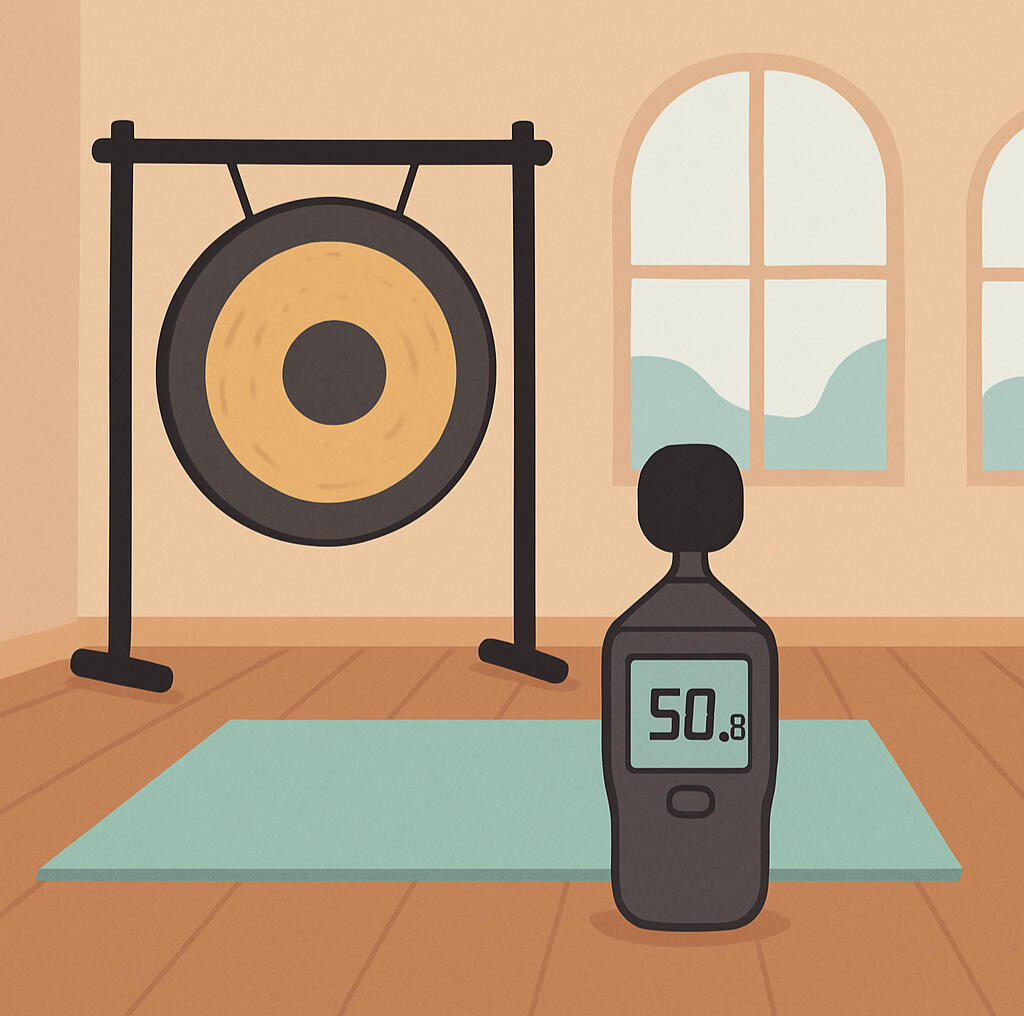
Approximately 10 million persons in the U.S. have permanent hearing loss from noise or trauma.NIDCD. Fact Sheet on Noise-Induced Hearing Loss. Washington, DC:HHS, 1999
Why This Matters
Yoga and wellness are there to help us heal, not harm our bodies. We’ve heard from students who’ve left classes with headaches, ringing in their ears, or emotional distress after loud experiences in wellness businesses. We’ve met teachers struggling with vocal fatigue and worried about their own long-term hearing damage. The lack of clear guidance, training, and awareness leaves both students and professionals vulnerable. In professional audio environments (touring shows, corporate meetings, and operas), these risks are handled responsibly.I believe this responsibility has a place in wellness practices as well.That’s why SharedSound.Space exists.We are a growing community of advocates, educators, and practitioners committed to restoring balance, awareness, and safety to the way sound is used in wellness spaces.
Sound healing isn’t just about feeling calm—it also supports physical healing. This is something that is a two way street, and we can develop a more mindful education about it. While more research is still being done, here’s what we know:Pain Reduction – Music therapy is being used in hospitals to help patients manage pain, especially after surgery. Certain tones and frequencies can trigger the release of endorphins (natural painkillers).Improved Sleep – Sound therapy can help those with insomnia by guiding the brain into a deeper sleep state. Listening to delta wave frequencies (deep, slow sounds) before bed can improve sleep quality.
“A sound bath is a deeply immersive, full-body listening experience that uses sound and simple mindfulness techniques to invite gentle yet powerful therapeutic and restorative processes to the mind and body,” says Sara Auster, a sound therapist, meditation teacher, and author of “Sound Bath: Meditate, Heal, and Connect Through Listening".
Join the Movement
-Explore safe sound practices-Share your story-Use our recommended free sound level self-check tools-Download posters and tip sheets for your studio or home practice-Get involved in upcoming campaigns and research
Three Main Things:
Education — Sharing research-backed resources for sound healing and safe sound practicesAdvocacy — Connecting with policy-makers, studios, and certifying bodies to help set safe standards about this invisible metricEmpowerment — Giving students and professionals tools to speak up and take action
🔍 How This Affects You
You may have experienced it without realizing:Ringing in your ears after loud practice or workout sessionFeeling overstimulated, agitated, or anxious after what should’ve been a calming sessionSore throat, vocal strain and raspy voice, or headaches from teaching or participating in wellness classes
What & Why?
There are physical signs that the soundscape is imbalanced — and potentially harmful. But this is something we can change, together.Whether you’re a yoga student, studio owner, a sound healer, or a member of an organization, this issue touches you. And together, we can fix it.These are not just minor inconveniences. Over time, they can lead to chronic issues that directly negate the intention of yoga, meditation, and sound healing.
📚 What the Research Shows
Sound Healing is a powerful & amazing practice. Being as wellness spaces are champions for healthy living, there would be some equation that shows equally evident a form of Sound Pollution must exist. If something can be used for healing, then when misused it can also be harmful. The best tool is knowledge.These findings come from audiology research, OSHA guidelines, and the World Health Organization’s safe listening recommendations — yet many student's remain unaware or inactive about the importance of sound.Modern wellness practices now include powerful audio tools: bluetooth or wired speakers, amplifiers, sound bowls and bells, as well gongs. The intensity in amplitude of sound has a measurable impact on both the nervous system and hearing health, which is completely separate from the pitch or tone. Just like driving a car has responsibilities, working with powerful audio devices does as well. Otherwise people can get hurt.Here’s some of what they said, that would be good for you to know:- Prolonged exposure to 85 decibels or higher can cause irreversible Noise-Induced Hearing Loss NIHL- Sounds above 100 dB, common in small studio spaces, can cause damage in under 15 minutes- Noise is a physical and emotional stressor, activating the fight-or-flight response, disrupting relaxation, and essentially undoing the intended effects of yoga or meditation- Fitness and yoga instructors are at particular risk, when teaching multiple loud sessions daily, often without hearing protection or using pro-actively monitored voice amplification
We are Empowered for our own health
🌱 What You Can Do
For Instructors and Studio Owners:- Measure your sound regularly (use an app or decibel meter)- Respectfully maintain a safe space that the music and instruments are below 85–90 dB across the room whenever possible- Offer hearing protection (disposable or reusable earplugs) for sensitive students or people seeming to be experiencing difficulty- Educate staff and offer quieter class options [ or please advertise directly that there are no quiet sessions ]- Add “Sound-Aware” class labels for client choiceFor Students and Practitioners:- Notice how you feel after class — energized or overwhelmed? Listen to the whole body, and then check-in again the next day.- Sit further from speakers or gongs if it gets overwhelming or is needed.-In new studios or spaces, when you sign up make sure to mention sensitivity to lights or sound, so teachers can to be aware.- Speak up (kindly and respectfully) if something feels too loud.
(And yes, difficult truth, some studios may push back for you even mentioning sound — but your health, safety, and well-being are worth speaking up for when things can be objectively measured)- Protect your ears — bring high-fidelity earplugs to class- Support studios that are sound-conscious and responsibly support their communities health
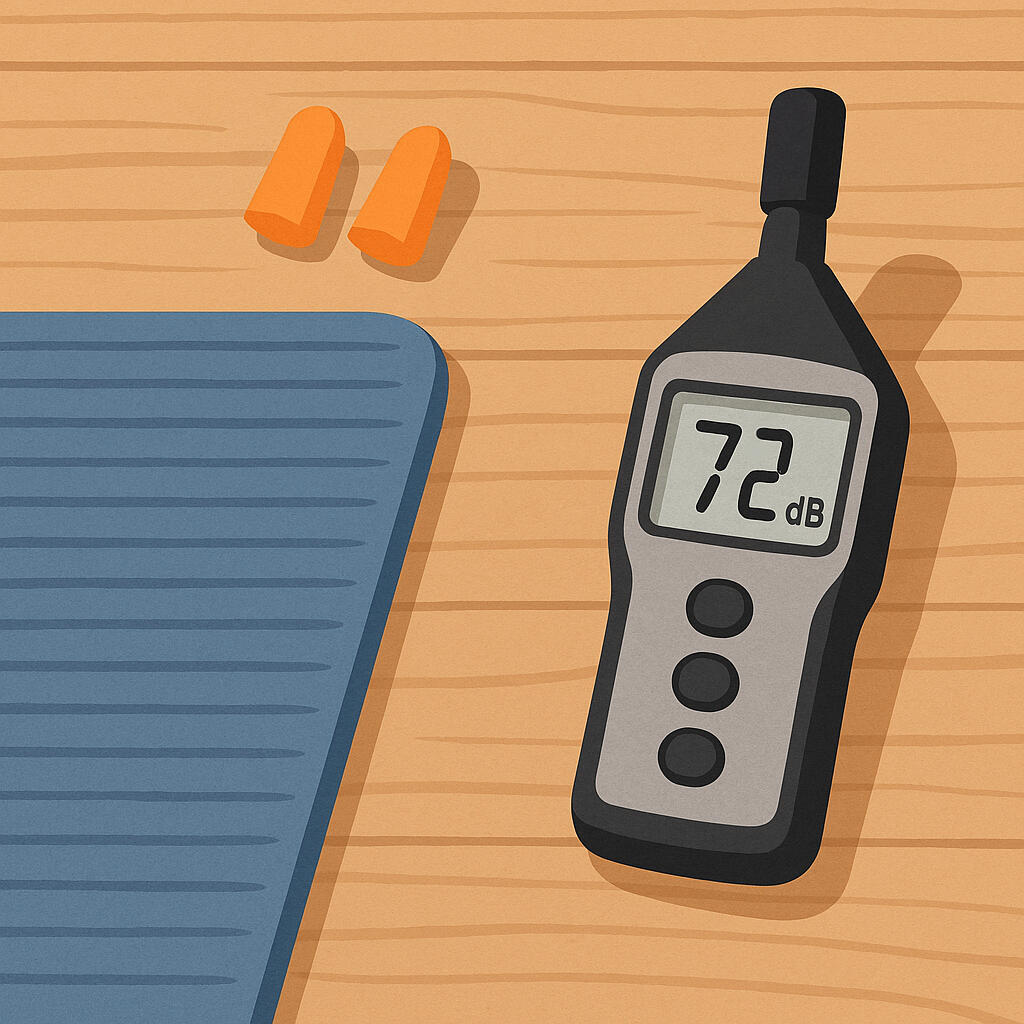
💬 Ready to Make a Difference?
Whether you’re a curious yogi, a studio leader, or a health professional, or simply are interested — we invite you to get involved.✅ Take our Yoga & Sound Awareness Survey🧠 Read our Educational Blog (coming soon)🗞 Join the Newsletter💬 Share Your Story with Us🤝 Request a Training or Studio Assessment
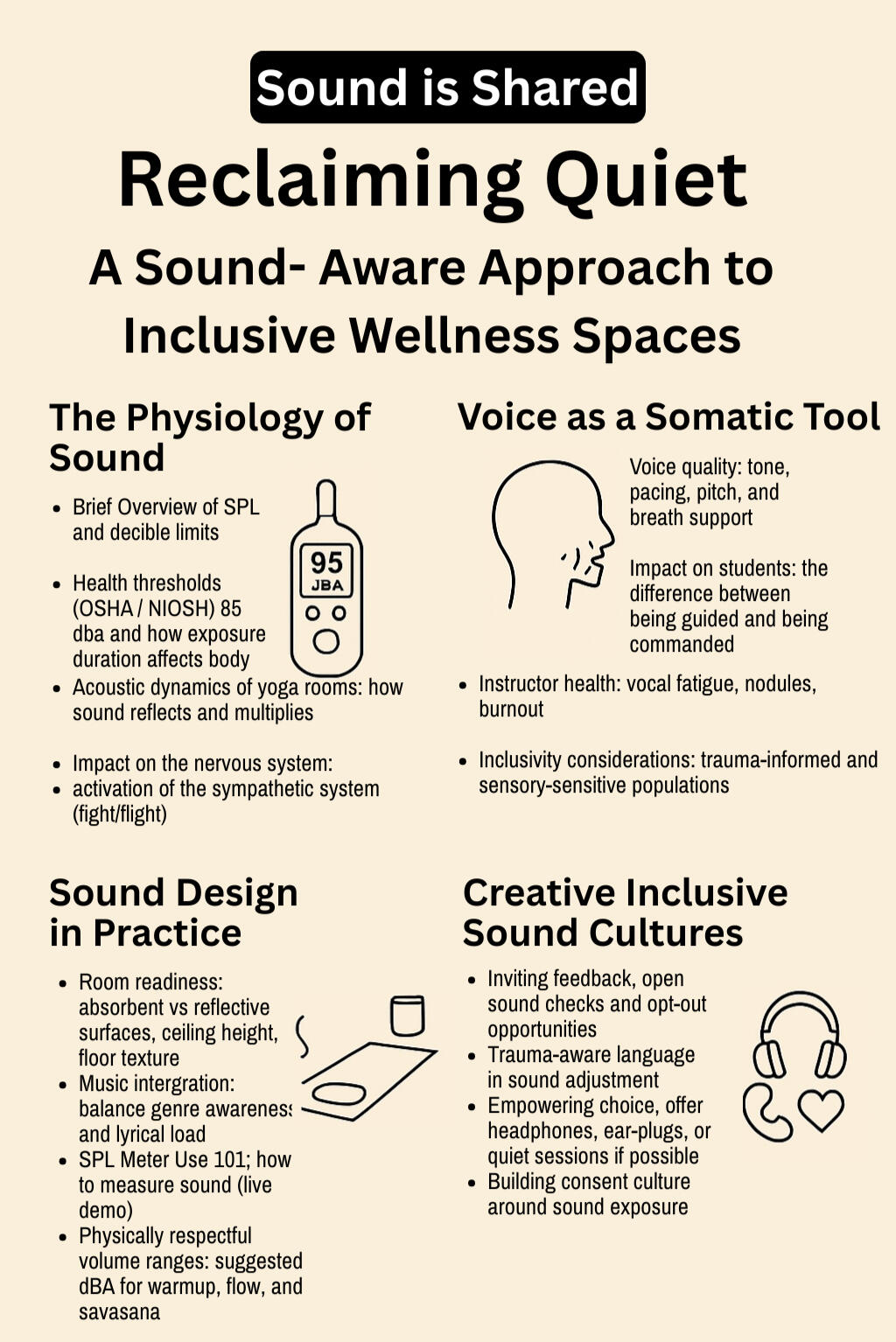
SharedSound.Space
📬 Subscribe for Updates & Advocacy Tools
Be the first to receive:+ Printable resources+ Sound-safe studio toolkits+ Webinars & continuing ed opportunities+ Research highlights+ Volunteer or ambassador opportunities
Sharing Safe Sound Spaces
Meet Richard
I'm Richard, an AES recognized Audio Engineer, Wellness Advocate, and Yoga Practitioner & Teacher (RYT200, 2019). I have experienced firsthand the harm that unchecked sound levels can cause in many studios. There should not be shame in engaging business owners to ask the audio practices of a studio. Being told that "People like it Loud" is no excuse for creating a measurably harmful situation under the label of wellness. It violates the sanctity of the practice and has been turned into a common practice of bullying instead of professional awareness of damaging environments.SharedSound.Space began as a passion project to bring awareness, education, and action to an issue too often ignored in the wellness industry. I believe that quiet can be powerful — and healing should never hurt.
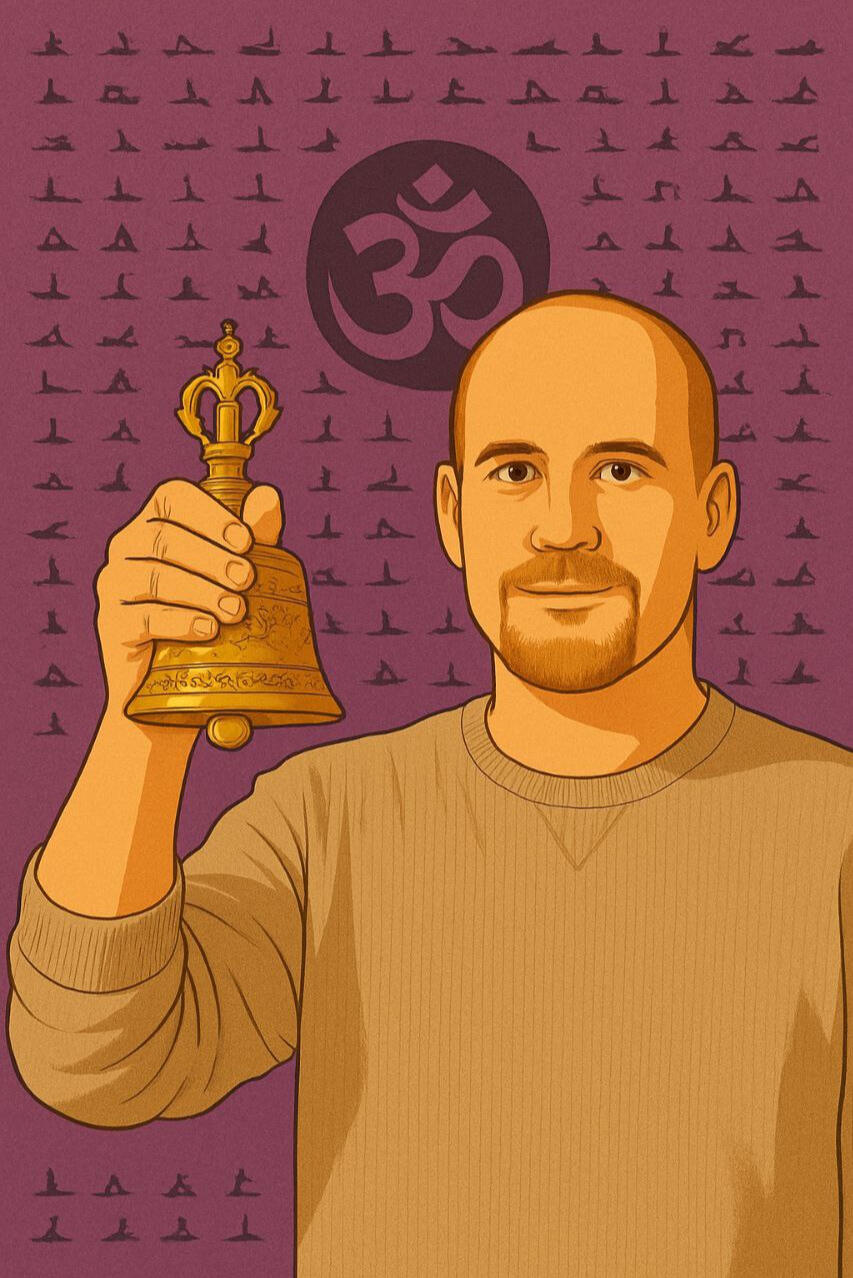
Upcoming Articles1. “When Healing Gets Loud: Why Yoga Spaces Need a Volume Check”A deep dive into how elevated sound in wellness settings is affecting hearing health and mental well-being.2. “What Is 85 dB, Anyway? Understanding Safe Sound in Real Life”Breaking down sound levels, safe exposure times, and how to use tools like Decibel X.3. “How to Talk to Your Studio About Volume — Without Conflict”Tips for students and instructors on advocating for lower volume in kind, effective ways.
Join our Newsletter
📬 Want to stay in the loop?
Join our community for updates, free tools, and upcoming advocacy actions.- Welcome kit PDF
- Monthly sound-safe wellness tips
- Priority invites to webinars & panels
- Studio-friendly printables for your spaceWellness should feel safe for every sense. Let’s build that together.

Let’s Turn the Volume Toward Healing
We’re not anti-sound. We’re pro-awareness. And when sound is used thoughtfully, it’s one of the most powerful tools for transformation we have.Join the movement — for quieter classes, stronger boundaries, and wellness that truly supports every sense.
